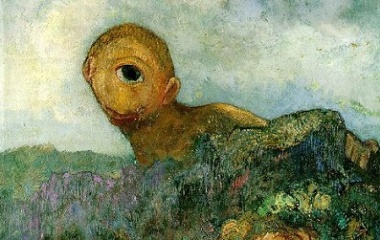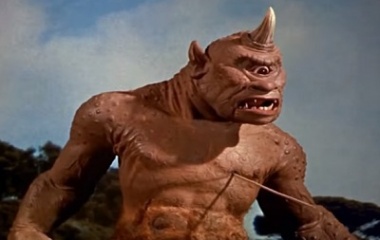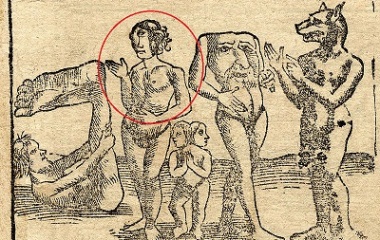Walk by one of Sicily’s rumbling volcanoes, and your mind might flit to rising magma or shifting tectonic plates—but the ancient Greeks who lived under the shadow of these volcanoes had a different explanation. They attributed the thunder and flashes of fire to the Cyclopes, a race of giants who labored in the dark belly of the earth.
What are Cyclopes?
Cyclopes (singular cyclops) are a race of giants, descended from the titans who proceeded the Greek gods. With a little discipline, they can create marvels, but for the most part, they are lawless and destructive creatures who accomplish very little.
Characteristics
Physical Description
Cyclopes are massive, lumbering beasts, so tall that a grown man would still fall below their knees. They have block-shaped heads with broad features and a single, round eye in the center of the forehead, right above the nose.
On top of their naturally crude appearance, these creatures make no effort to look civilized. They allow their hair and beards to grow into tangled masses, wear rough clothing made from animal skins, and hardly ever bathe.
In The Odyssey, Homer gave a definitive description of the cyclops:
“A monstrous ogre, unlike a man who had ever tasted bread, he resembled rather some shaggy peak in a mountain-range, standing out clear, away from the rest.”
Other writers after Homer took his Cyclops as a model for their own, creating a race of similarly barbaric giants.
Personality
While you can’t judge all monsters by their appearance, the Cyclopes crude shape is a pretty good representation of their true character.
First and foremost, Cyclopes are antisocial. They reject all forms of structured society, refusing to honor the gods, abide by the laws of men, or even remain faithful to each other. They live in small tribes, which are usually isolated on an island or in the mountains. Within these tribes, there is no form of government; each creature has his own cave, and he rarely visits his brethren. Sometimes, a Cyclops will share his cave with a wife or small child, but this is the limit of his friendliness. Indeed, if a human stumbles into one of these monsters’ caves, he will probably be torn from limb to limb and eaten, rather than welcomed as a guest.
By many accounts, Cyclopes are lazy and sloppy as well as antisocial. Rather than farming their land, like men do, they forage for grains and berries that happen to grow in the wilderness around them—or they steal more nourishing crops from nearby towns.
But other accounts contradict the image of the lazy Cyclopes. The Cyclops in Homer’s Odyssey is a diligent shepherd, with all of his goats divided into well-kept pens. He even puts their goatmilk to good use, making butter and curds. Likewise, Hesiod and Callimachus reported that the monsters were terrific craftsman, charged with forging weapons and building fortifications for the gods.
Special Abilities
Aside from their brute strength, the Cyclopes are a rather un-talented bunch. They don’t seem to have an instinct for self-improvement, like humans do, so they rarely progress beyond the few skills they were born with.
Craftsmanship is their most noble claim to fame. They can be excellent blacksmiths, making such mighty exertions that their underground forges are mistaken for volcanic activity. They have a unique ability to incorporate heavenly materials, like sunlight, moonlight, and lightning into their products as well, which makes them popular smithies with the gods. They are also talented masons because their strength allows them to transport and stack massive stones, building tall, impenetrable walls.
In a few rare cases, these beasts have been unleashed on the battlefield to devastating effect. Although they don’t have the selflessness or the sense of “a greater good” which makes a true war hero, they are still powerful warriors. Their bloodlust, combined with a dull intellect, means that they will willingly lead the charge onto a battlefield and slaughter hundreds of men.
Cultural Representation
Origin
This giant race springs from Greek mythology, appearing in epic tales as far back as Homer’s Odyssey and Hesiod’s Theogony, written in 8 BC. After the creature gained popularity in poems and legends, he was taken as a study of subject for early scholars like Plato, Ovid, and Pliny the Elder.
The word “cyclops” also appears to have debuted in Greece. Originally it meant “round eye” or “circle eye,” which, of course, described the Cyclops’ most famous feature: his single, bloated eye.
Famous Cyclopes
The most famous Cyclopes in history is Polyphemus, who stars in The Odyssey and, subsequently, appears in various other tales. Polyphemus was a giant shepherd who lived in a cave on a mountainous island. When Odysseus and his crew landed on Polyphemus’ island and saw how well he took care of his flock, they thought he might make a kind host, after their harrowing journey. Accordingly, the men approached the beast in his cave, and Odysseus requested that the Cyclops honor the gods by welcoming them into his home. Instead, Polyphemus rolled a giant stone in front of the cave’s mouth, trapping the men, and began to eat them one by one. After he had feasted on several men, the glutton began to make small talk with Odysseus, who, ever the silver-tongue, claimed that his name was “Noman.” The next morning, after Polyphemus rolled the stone away from the cave’s mouth so that he could go and tend to his flock, Odysseus launched a daring attack, stabbing the monster in his single eye and blinding him. The beast wailed in agony, but when the neighboring Cyclopes arrived to see what was the matter, Polyphemus said that “Noman (no man) had attacked him.” The other Cyclopes were annoyed that they had been disturbed for nothing, and they departed, allowing Odysseus and the other men to escape back to their ship. Unfortunately, the rest of their sea-voyage was miserable because Poseidon, father of Polyphemus, was angry that they had wounded the Cyclops.
Second to Polyphemus, the most famous Cyclopes are a trio of brothers: Brontes (thunder), Steropes (lightning) and Arges (bright). According to Theogony, these brothers were born to the titans Uranus (sky) and Gaia (earth), but their father feared their strength and exiled them Tartarus, a horrible abyss that lies even below Hades. Eventually, Zeus freed the brothers from their terrible dungeon, and in return, they forged thunderbolts for him to use in his next plot: the overthrow of the titans. With the Titans deposed, Zeus allowed the Cyclopes free roam of the world, but many years in Tartarus had warped their minds, and they preferred to remain underground at their forges. They continued to produce spectacular weapons for the gods, including Poseidon’s trident, Artemis’ bow and arrows of moonlight, Apollo’s bow and arrows of sunlight, and a helm of invisibility for Hades.
Explanation of the Myth
On the surface, the Cyclopes may seem like just another invention of Greece’s runaway imagination, but modern scholars have proposed several real occurrences that might have inspired these primordial giants.
The monsters may have represented a very real group of people, a group that had a reputation for being strong, solitary types: blacksmiths. Wielding a blacksmith’s tools took great natural strength, and on top of that natural strength, blacksmiths amassed huge muscles from hours of work with their hammers. During Greek times, they were also very protective of their trade secrets, passing their knowledge on to only one or two apprentices and giving everyone else the cold shoulder. Tellingly, many blacksmiths also wore a patch over one eye, to prevent the sparks and smoke from their forge from blinding them in both eyes.
Another explanation for Cyclopes is the dwarf elephant, a species that roamed Greece long before Greeks did. The dwarf elephants’ skulls have a large opening in the middle of what appears to be their forehead. In reality, this opening was a naval cavity that connected to the trunk, but it may well have looked like an eye cavity to a Greek person, who had never seen a dwarf elephant.
Finally, a condition called cyclopia may have been brought on by the use of white hellebore, a dangerous mutagen which the Greeks mistook for a medical herb. Children born with cyclopia have a conjoined eye beneath their nose, which would certainly alarm any Greek person. However, cases of cyclopia, even when the mother is exposed to white hellebore, are very rare, and the children rarely live past infancy, making it unlikely that they would be connected with a giant race of monstrous strength.











yeah i want to know to
5 foot long
in feet
how tall can they be
so there are no girl cyclopes in greek myth?